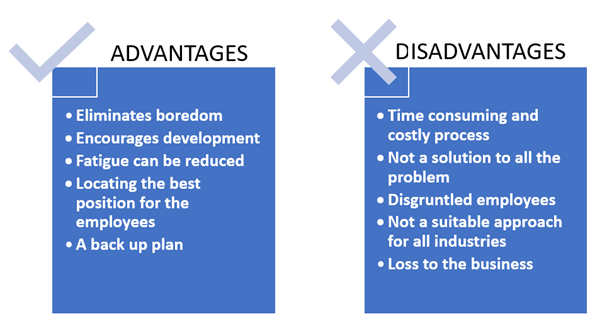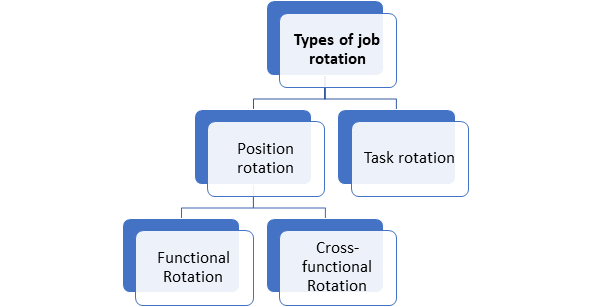What is job rotation?
In job rotation, employees are shifted from one job role to another or to other assignments and projects at regular intervals and provide extensive exposure to the employees from different verticals of an organisation. This management approach also helps in assessing the employee’s skills from different perspectives and place them in the right position or department. Moreover, job rotation increases job satisfaction as the monotony of the work can be reduced and extending them more insights.
Job rotation can be considered as a management practice in which the hidden potential of the employees can be explored and the boredom amid the employees can be reduced significantly. Such a practice is beneficial for both employees and the management.
Summary
- In job rotation, employees are shifted from one job role to another at regular intervals.
- Job rotation provides extensive exposure to the employees from different verticals of an organisation.
- The job rotation management approach also helps in assessing the employee’s skills from a different perspective and place them in the right position or department.
- Job rotation increases job satisfaction as the monotony of the work can be reduced, extending them more insights.
Frequently Asked Questions (FAQs)
What is the objective of job rotation?
- Incentivising the job: The foremost objective of job rotation is to decrease work related monotony. Furthermore, the employees are given the opportunity to experience a range of jobs and they are motivated to perform well in the different job role.
- Creating a backup: The job rotation helps in succession planning that is creating a pool of employees who can be placed at the higher level of management when a senior leaves the organisation. Therefore, an immediate replacement is located within the organisation.
- Finding the perfect role: Job productivity leads to organisational success. When an employee is placed at the right job, then they are able to increase their overall productivity. One of the crucial components of job rotation is to put the right person at the right job.
- Increased exposure for workers: The job rotation process exposes the employees to the different verticals of the organisation and informs the workers regarding the company’s operations and the way the organisation deals in different departments. It gives them the opportunity to acknowledge the challenges which may arise during working hours.
- Employees skills assessment: By adoption of the job rotation process, the organisation is able to assess the competencies and skills of the employees in different areas. On the basis of the assessment, the employees are placed in a position where they can show higher productivity.
- Wider range of work experience: Generally, employees may not be open to changing their job responsibilities as they get comfortable with their current role. Job rotation prepares the employees for a higher level of work experience and makes them flexible to working in different areas and develop their competencies. Moreover, employees can understand the issues which arise in different departments and the techniques to address the same.
What are the advantages of job rotation?
- Eliminates boredom: The disengaged employees can be motivated by giving them a challenging job. Giving new responsibilities will not be the only solution but it will prevent boredom and might increase the engagement rate. Over a period, employees can become disinterested, but monotony can be broken by mixing upon their responsibilities and can potentially increase the retention rate of employees.
- Encourages development: By job rotations, employees feel that they are valuable for the industry as an organisation is giving them an opportunity to enhance their skills.
- Fatigue can be reduced: In the manufacturing industry, more manual work is involved. When an overworked employee is given the opportunity to work in a less loaded work, then fatigue reduces significantly.
- Locating the best position for the employees: The organisation is able to ascertain the best place for the employees during the whole job rotation process.
- A back up plan: During job rotation, the organisation is able to leverage the skills of all the employees. In case a senior position manager leaves the organisation on short notice, then the organisation has a backup plan.
What are the disadvantages of job rotation?
- Time consuming and costly process: When an employee is rotated from one job to another, then there is a learning curve, that is, the employee has to train for a new job role which can take a lot of time and training
- Not a solution to all the problem: Job rotation does not guarantee success or employee engagement; therefore, the organisation should strategically identify the employees who are suitable for job rotation.
- Disgruntled employees: Few employees might not be comfortable with the idea of job rotation as they are satisfied with their current position and role. Therefore, job rotation can sometimes hamper the satisfaction of the employees.
- Not a suitable approach for all industries: This is true for those industries where employees need to be trained considerably to perform a specific duty. In case of the rotation, the company can lose their skilled employees.
- Loss to the business: An organisation can suffer significantly as the chances of error increases as all the employees might be under training and the organisational demands are not met in time. Moreover, during job rotation at the top level, the bottom line labour is highly affected.

Source: Copyright © 2021 Kalkine Media
What are the types of job rotation?
Job rotation is of two types,
Task rotation – Those employees who are engaged in stressful work or work which demands physical workload is usually approached through task rotation. The employees are placed into less stressful work and given a break from their everyday routine work.
Position rotation – The location, position or designation of an employee is changed, and he/she is given the opportunity to gain different competencies and skills. This is further divided into functional and cross functional rotation. In functional rotation, the functions do not change but in cross-functional, the job responsibilities or department is changed completely.

Source: Copyright © 2021 Kalkine Media
 Please wait processing your request...
Please wait processing your request...